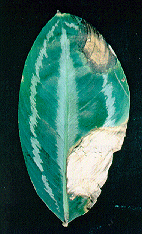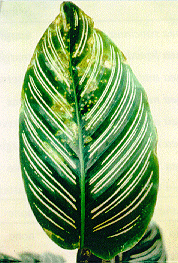 Fig 1. Pseudomonas
leaf spot on Calathea argentea 'Vandenheckei' caused by P.
cichorii.
Fig 1. Pseudomonas
leaf spot on Calathea argentea 'Vandenheckei' caused by P.
cichorii. Return to: CFREC Home Page
Return to: CFREC Research Index
A. R Chase*
University of Florida, IFAS
Central Florida Research and Education Center - Apopka
CFREC-Apopka Research Report, RH-93-11
Bacterial leaf spot of Calatheas can be caused by either Pseudomonas cichorii which is fluorescent in culture or another Pseudomonas sp. which is nonfluorescent. Symptoms of Pseudomonas leaf spot (P. cichorii) are characterized by water-soaked spots that turn dark green to black. They may have a yellow edge but this is not common. Calathea roseo-picta and C. 'Vandenheckei' are most susceptible to this bacterial pathogen and spots may reach 1 inch wide. There are rarely more than two spots on a leaf and loss of the leaf often occurs if it is infected before complete expansion (2).
 Fig 1. Pseudomonas
leaf spot on Calathea argentea 'Vandenheckei' caused by P.
cichorii.
Fig 1. Pseudomonas
leaf spot on Calathea argentea 'Vandenheckei' caused by P.
cichorii.
Symptoms of the Pseudomonas blight (Pseudomonas sp.) are somewhat different. This bacterial disease has become a problem for calathea growers during the past two years (1). Symptoms start as water-soaked areas along the leaf veins and are especially visible on new leaves as they open up. The spots appear clear and run together readily. When completely mature, the spots are tan to brown and papery. C. roseo-lineata is very susceptible to this pathogen, with severe symptoms developing even when drip irrigation is used to keep leaves as dry as possible.
 Fig 2. Pseudomonas
blight on Calathea roseo-lineata caused by Pseudomonas
sp.
Fig 2. Pseudomonas
blight on Calathea roseo-lineata caused by Pseudomonas
sp.
Control of Pseudomonas leaf spot should be based on eliminating overhead watering as much as possible to reduce conditions for infection and spread of the bacterium between plants. Preventive applications of a copper bactericide may aid in disease control but none are labeled for calathea at this time. Control of Pseudomonas blight is more difficult. Infected plants should be destroyed since the bacterium is systemic in infected plants. Although tissue culture plants may be free of the disease when purchased they are as easily infected as cuttings. Other controls mentioned for P. cichorii can be used as well.
Since Pseudomonas blight is so difficult to control even when the best cultural conditions prevail the following studies were undertaken to determine resistance of some Calatheas and related plants to this bacterial pathogen. The table lists the plants tested for susceptibility to Pseudomonas blight. Many calatheas and all marantas tested were immune to the pathogen while Stromanthe 'Burle Marx' was as susceptible as C. ornata.
*Professor of Plant Pathology, University of Florida, IFAS, Central Florida Research and Education Center - Apopka, 2807 Binion Rd., Apopka, FL 32703-8504.
References
1. Leahy, Robert. 1991. Bacterial leaf spot of Calathea spp. Pl. Path. Circ. No. 345, Fl. Div. of Pl. Industry. (not in print)
2. Wick, R. L. and Robin Shrier. 1990. Pseudomonas leaf spot of Calathea picturata 'Argentea'. Phytopathology 80:124.
| Plant | Symptoms | Suseptibility levelx |
|---|---|---|
| Calathea concinna | marginal/interveinal burning | low to medium |
| Calathea leperdina | marginal burning | slight |
| Calathea majestica | interveinal burning | low to medium |
| Calathea makoyana | none | immune |
| Calathea ornata | interveinal burning | very high |
| Calathea roseo-picta | marginal burning | low to medium |
| Calathea vittata | none | immune |
| Calathea wilson-princep | scattered spots | high |
| Ctenanthe lubersii | none | immune |
| Maranta leuconeura 'Green' | none | immune |
| Maranta leuconeura 'Red' | none | immune |
| Maranta leuconeura 'Blue' | none | immune |
| Stromanthe amabilis 'Burle Marx' | marginal and tip burning | very high |
xSusceptibility was rated from lowest to highest: immune, slight, low, medium, high and very high.